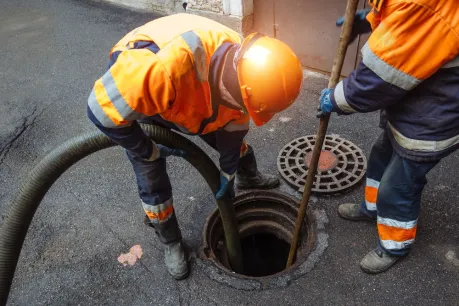Understanding Manhole Accidents: Why They Happen and Who Is at Risk

Key Takeaways
- Manhole accidents cause severe injuries. Studies show victims frequently suffer fractures, head trauma, internal injuries, and long-term complications after falls into open or unsecured manholes.
- Negligence is often the root cause. Missing covers, corroded infrastructure, inadequate inspections, and unmarked work zones pose a risk to the public and can lead to liability.
- Some manhole hazards involve toxic or oxygen-deficient environments. Confined-space accidents can be fatal; studies show how a lack of proper safety protocols can lead to preventable deaths.
- You don’t have to navigate this alone. Morgan & Morgan offers a free case evaluation, and the Fee Is Free®; you don’t pay anything unless we win your case.
Injured?
Open manholes and defective utility covers aren’t just city-maintenance problems; they’re serious public-safety hazards that can leave victims with catastrophic injuries, lifelong disabilities, or even worse. These incidents can occur anywhere, and when they do, victims are often left paying the price.
Manhole Accident Lawyers: Protecting the Injured and Holding Negligent Parties Accountable
Manholes are part of everyday life. They support sewer systems, storm drains, telecom lines, and essential utilities. Most people walk past them without a second thought, until one is left open, unstable, unmarked, or structurally compromised.
These hazards are far more common than most realize. For pedestrians, cyclists, motorcyclists, construction workers, sanitation teams, and utility crews, a momentary lapse by a negligent party can result in devastating consequences.
When the people responsible fail to maintain, secure, or properly mark hazardous openings, the consequences fall entirely on the unsuspecting person who happens to be in the wrong place at the wrong time.
Morgan & Morgan stands up for people who are hurt because someone else didn’t take their responsibility seriously. If you or someone you love fell into a manhole, was injured by a defective cover, or was harmed in a sewer or utility incident, you may be entitled to compensation for medical care, lost wages, and the pain you and your family have endured.
What the Research Shows: Manhole Falls Are Far From “Freak Accidents”
A large study published on PubMed from several years ago examined 388 trauma patients who suffered injuries after falling into open manholes. The findings were alarming:
- The majority required surgical intervention.
- Many experienced fractures, spinal trauma, or internal injuries.
- A significant portion suffered moderate to severe head trauma.
- Complications were often long-term, with some victims requiring extended rehabilitation or multiple procedures.
These numbers highlight a profound truth: when safety protocols fail, the human body bears the full brunt of the impact, and that impact can profoundly shape the rest of a person’s life.
Common Causes of Manhole Accidents
Manhole accidents don’t “just happen.” They typically trace back to preventable errors, oversight, or negligence. Some of the most frequent causes include:
Missing or Dislodged Covers
Covers can be knocked loose by vehicles, improperly replaced by contractors, stolen for scrap value, or removed during work without proper barricades. A missing cover creates an immediate fall hazard.
Corroded or Defective Infrastructure
Aging metal can weaken over time. If a cover collapses under someone’s weight, the fall can be unpredictable and extremely violent.
Poorly Marked Work Zones
When crews open a manhole for maintenance, the area must be secured with warnings, fencing, and protective barricades. A single missing cone can mean disaster for a pedestrian or cyclist.
Weather-Related Damage
Flooding, soil erosion, or storm runoff can destabilize the ground around a manhole, creating hidden hazards beneath the surface.
Construction Negligence
If multiple teams are working on underground utilities, communication breakdowns can result in unsafe openings being left exposed.
Improper Safety Protocols in Sewer or Utility Spaces
Some of the most dangerous manhole hazards occur below the street surface, where confined-space rules must be followed. Failure to follow Occupational Safety and Health Administration (OSHA) standards can cause asphyxiation or fatal toxic-gas exposure.
Confined-Space Dangers: Lessons From Real Cases
A powerful example of preventable tragedy comes from an Oklahoma Municipal Assurance Group (OMAG) case study. In this documented incident, a worker entered a sewer manhole without proper confined-space testing, leading to a fatal collapse due to oxygen-deficient air. According to the report:
- The air inside the manhole contained dangerously low oxygen levels.
- No atmospheric testing or ventilation was performed.
- Rescue personnel also faced severe risk.
- OSHA’s confined-space safety standards were not properly followed.
This case underscores a grim reality: manhole hazards are not only physical. They can be silent and invisible, and they can turn deadly within seconds.
Injuries Commonly Seen in Manhole Accidents
Because manholes often drop several feet, sometimes up to two stories, the injuries can be severe, multi-systemic, and long-lasting. Common injuries include:
- Traumatic brain injuries (TBIs)
- Skull or facial fractures
- Spinal cord damage or disc herniation
- Broken arms, legs, ribs, or pelvis
- Internal bleeding and organ injury
- Deep lacerations and soft-tissue trauma
- Chemical burns or infections (in sewer-related cases)
- Long-term emotional trauma or PTSD
Many victims require extended hospitalization and follow-up care, sometimes for years.
Who May Be Liable for a Manhole Accident?
Manhole responsibility is shared across various entities, depending on location and purpose. Potentially liable parties include:
Municipalities or Local Governments
Cities are often responsible for storm drains, sewer systems, and roadway infrastructure. Failure to inspect, maintain, and secure manholes can create liability.
Utility Companies
Telecom, gas, electric, and internet providers frequently use underground systems. Their crews must follow safety rules while leaving work zones secure.
Contractors and Subcontractors
Construction teams working near underground utilities must close, secure, or barricade openings. Neglecting this duty can make them liable.
Third-Party Maintenance Crews
Private contractors hired for maintenance must adhere to strict safety protocols.
Property Owners
If the manhole is located on private land (e.g., a commercial parking lot), the property owner or manager may be held responsible.
Determining liability often requires expert investigation, including site analysis, evidence preservation, review of video footage, and examination of maintenance logs.
What to Do After a Manhole Accident
If you or someone you love is injured because of an unsafe manhole, your next steps can significantly affect your physical recovery and the strength of your case.
- Get medical attention immediately. Even if you don’t think you’re seriously hurt, internal injuries, spinal trauma, and head injuries may not be immediately obvious.
- Report the accident. Notify local authorities or property management to create an official record.
- Document the scene. Photos and videos of the open or defective manhole, missing barricades, puddles, construction markings, or the surrounding area can be critical evidence.
- Get witness information. Anyone who witnessed the fall or conditions leading up to it may be able to help your case later.
- Contact a lawyer as soon as possible. Manhole cases require fast action to preserve evidence before conditions change or repairs are made.
How Statutes of Limitations Affect Your Case
Every state has its own deadline for filing a personal injury lawsuit, called the statute of limitations. Some states allow two years, some allow three or more. Cases involving government entities often have even shorter deadlines and special procedural requirements, such as:
- Notice-of-claim filings
- Shortened reporting periods
- Mandatory administrative steps before suing
Missing these deadlines can prevent you from pursuing compensation, even if your case is strong. That’s why early legal guidance is essential.
How Morgan & Morgan Can Help
Manhole cases can be complex. They often involve government agencies, utility companies, private contractors, and multiple layers of insurance. Our attorneys know how to navigate these systems and uncover the truth about what went wrong.
When you work with Morgan & Morgan, you get:
- A law firm with decades of experience handling complex infrastructure and injury cases
- Access to investigators, engineers, and safety experts
- The ability to take your case to trial when insurers won’t act fairly
- A team that understands how life-changing these injuries can be
We fight to recover compensation for:
- Medical bills
- Future treatment or rehabilitation
- Lost wages and lost earning capacity
- Pain and suffering
- Permanent disability
- Wrongful death damages for families
Contact Morgan & Morgan Today
If you or someone you love was injured because of an unsafe manhole or defective utility cover, you deserve answers and justice. Morgan & Morgan has the resources, experience, and national reach to stand up to negligent parties and help get you the compensation you need to move forward. The Fee Is Free® promise means you don’t pay anything unless we win. Fill out a free case evaluation today and let our team fight for you.

We've got your back
Injured?
Not sure what to do next?
We'll guide you through everything you need to know.
